On the first day of this year we had a block party—no snow here. It was one of those events where you barricade the street, set out card tables with food, watch the kids enjoying being free to ride and play in the middle of the street, and chat with your neighbors—the ones you know and the ones who you haven’t met yet. No surprise, I talked to several of my neighbors about yoga (it’s Berkeley after all!). Several were thinking that Yoga for Healthy Aging might be the thing for them and wanted to see the new book, so I brought it out. That led to some interesting conversations!
One woman told me she liked the fact that the book had variations for all the poses because her problem was she couldn’t do any poses lying down because she always felt nauseated when she was lying down, and that her doctor told her just not to do them. While I don’t usually hear about people who can do poses standing up but not lying down—I usually hear the opposite—it reminded me of an important basic principle regarding making a pose accessible: change the orientation of the pose!
In my neighbor’s case, for example, a pose we do lying down, such as Reclined Leg Stretch, can be done standing up as Standing Leg Stretches with the lifted leg supported by a chair or something higher like a counter top. For those with the opposite restriction, for Standing Leg Stretches, you would do Reclined Leg Stretch. And for Cobra pose, which is normally done on the floor, Jivana Heyman has a really nice variation that you do standing with your hands on the wall. Once you start thinking along these lines, you’ll find a way to do almost any pose. See Jivana’s posts Tree Pose Variations for Every Body and Cobra Pose Variations for Every Body for some other examples, and here’s a photo of his I saw recently, which uses this changing the orientation technique for Eagle Pose.
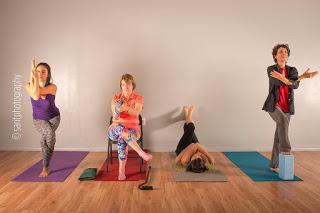 So if you have a temporary or permanent physical limitation that prevents you from being able to do a certain pose even with props, try changing the orientation of the pose. Although you won’t get exactly the same physical benefits from the pose when you change its orientation, you will still be taking the basic shape of the pose, which can help you maintain flexibility and range of motion as well as strength. And taking a variety of shapes will help your coordination and fine muscle control. It will also allow you to expand your repertoire of poses when you are restricted so you don’t have to do just a few poses over and over. You can also make any orientation a yogic asana by using a mental focus and practicing wisdom in action, as I described in my post What is the difference between exercise and yoga?, so you're not losing out on any of those benefits! Finally, if you’re in class, this will help you figure out what do on your own if your teacher is busy with something else.
So if you have a temporary or permanent physical limitation that prevents you from being able to do a certain pose even with props, try changing the orientation of the pose. Although you won’t get exactly the same physical benefits from the pose when you change its orientation, you will still be taking the basic shape of the pose, which can help you maintain flexibility and range of motion as well as strength. And taking a variety of shapes will help your coordination and fine muscle control. It will also allow you to expand your repertoire of poses when you are restricted so you don’t have to do just a few poses over and over. You can also make any orientation a yogic asana by using a mental focus and practicing wisdom in action, as I described in my post What is the difference between exercise and yoga?, so you're not losing out on any of those benefits! Finally, if you’re in class, this will help you figure out what do on your own if your teacher is busy with something else. Now let’s take a closer look at four different ways you can change the orientation of a pose.
Lying Down
You can generally take the shape of any standing pose lying with your back on the floor with your feet on the wall, as if the wall was the floor and the floor was a wall. For example, here is Tree pose on the floor:
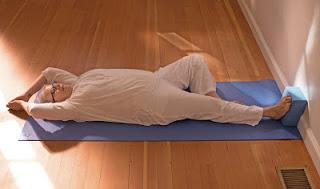 When you do the pose on the floor, rather than just resting against the floor in the shape of the pose, activate the same muscles that you would as if you were standing, so you’re actively doing the pose. For example, in Tree pose, firm your “standing” foot into the wall as you press the foot of your bent leg toward your thigh and press your inner thigh toward the foot. Reach your arms overhead and activate them, as if you were reaching them up toward the ceiling.
When you do the pose on the floor, rather than just resting against the floor in the shape of the pose, activate the same muscles that you would as if you were standing, so you’re actively doing the pose. For example, in Tree pose, firm your “standing” foot into the wall as you press the foot of your bent leg toward your thigh and press your inner thigh toward the foot. Reach your arms overhead and activate them, as if you were reaching them up toward the ceiling. You can even do Handstand by lying on your back with your hands on the floor! Keep the imagine of the classic pose in your mind as you activate your entire body.
Seated on a Chair
You can generally take the shape of any pose with either part or all of your body when you are seated on a chair. If you can move your legs, your legs can take the same shape they would if you were standing without putting weight on them. Even though your pelvis is supported by the chair, in chair poses you’re still working against gravity to hold yourself up so a chair version of a standing pose can be surprisingly physically demanding (I have tried them!) Here are some examples:
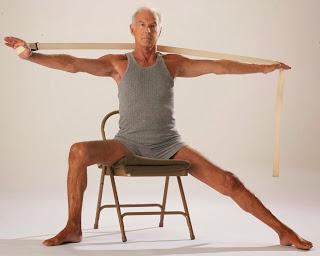
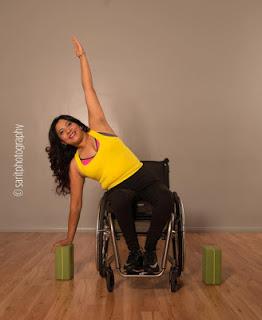 For those who can’t do prone or restorative poses on the floor, you can often use two chairs and a lot of props to get into a close approximation of the pose.
For those who can’t do prone or restorative poses on the floor, you can often use two chairs and a lot of props to get into a close approximation of the pose. 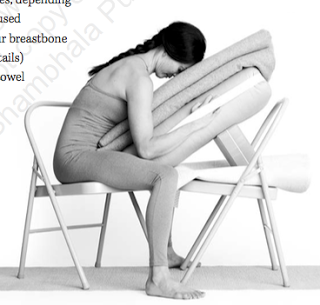 These days I’m encouraging everyone who can get up and down to the floor even with some help from a prop and/or stand up even with support to try to do poses without sitting on a chair, both standing poses and floor poses. Even if it’s very challenging for you, I think it’s worth your effort to maintain the agility and balance you do have by continuing to work on both skills. So if they are possible, consider doing some floor and standing poses as well as chair poses. This photo shows using a chair while standing in Tree pose to help with balance and strength.
These days I’m encouraging everyone who can get up and down to the floor even with some help from a prop and/or stand up even with support to try to do poses without sitting on a chair, both standing poses and floor poses. Even if it’s very challenging for you, I think it’s worth your effort to maintain the agility and balance you do have by continuing to work on both skills. So if they are possible, consider doing some floor and standing poses as well as chair poses. This photo shows using a chair while standing in Tree pose to help with balance and strength.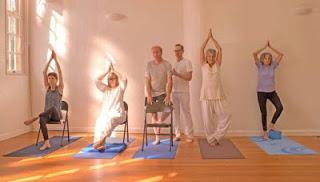 Standing
Standing If you think of the wall as the floor, there are many prone poses, like Cobra pose, that you can do standing with part of your body against the wall.
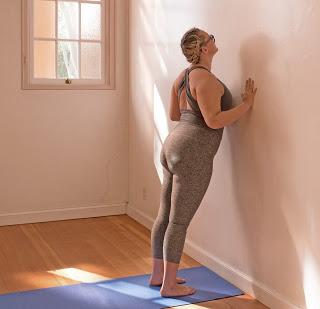 For example, I can see doing Locust pose with your hip points against a wall and arms lifted behind you or Plank pose with either hands or forearms on the wall. And Jivana has promised one day he’ll share his wall version of a Sun Salutation!
For example, I can see doing Locust pose with your hip points against a wall and arms lifted behind you or Plank pose with either hands or forearms on the wall. And Jivana has promised one day he’ll share his wall version of a Sun Salutation! One advantage of standing at the wall over lying on the floor is that there is less weight on your hands, so these variations are very good for those with problems in the wrists or hands. Half Downward-Facing Dog pose at the wall is the classic example of this:
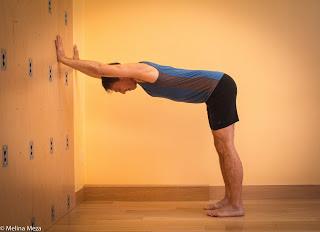 The wall version of Side Plank pose is another example.
The wall version of Side Plank pose is another example.  And because your orientation to gravity is different—you no longer have to lift yourself up away from the ground—these versions are less physically demanding so they're good for those who are weak or tired (I know that Bonnie Maeda teaches wall vinyasas to her students with cancer).
And because your orientation to gravity is different—you no longer have to lift yourself up away from the ground—these versions are less physically demanding so they're good for those who are weak or tired (I know that Bonnie Maeda teaches wall vinyasas to her students with cancer). I can even imagine some supine poses against the wall, such as a passive backbend with a prop behind your shoulder blades and arms reaching up toward the ceiling or a wall version of Reclined Leg Stretch.
Obviously relaxing reclined poses are not going to be relaxing if you do them standing up, so for restorative supine or prone poses, I would recommend using two chairs and a lot of props instead as mentioned above.
Upside-Down vs. Right-Side Up
For those who cannot go upside down into a full inversion, you may be able to do a partial inversion in the form of a similar pose. For example, an alternative to Headstand is to do a Standing Forward Bend with your head on a block (or two) or to do Widespread Standing Forward Bend with head support. I did both of those when I had a frozen shoulder.
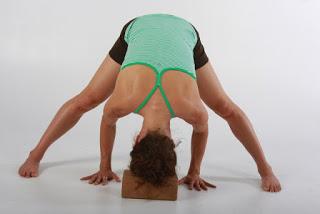 Instead of a Shoulderstand, you could do a supported Bridge Pose, which is a much more gradual inversion which puts much less weight on your neck.
Instead of a Shoulderstand, you could do a supported Bridge Pose, which is a much more gradual inversion which puts much less weight on your neck. You can also try the pose right side up, such as Handstand with your feet on the floor and your hands in the air, as if they were touching the ceiling. I’ve seen fellow students doing that in class.
Subscribe to Yoga for Healthy Aging by Email ° Follow Yoga for Healthy Aging on Facebook and Twitter ° To order Yoga for Healthy Aging: A Guide to Lifelong Well-Being, go to Amazon, Shambhala, Indie Bound or your local bookstore.

